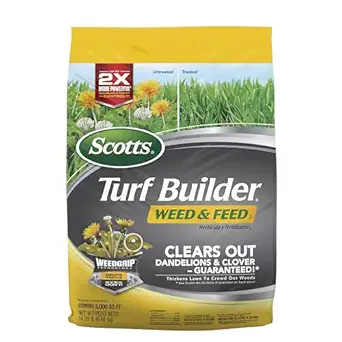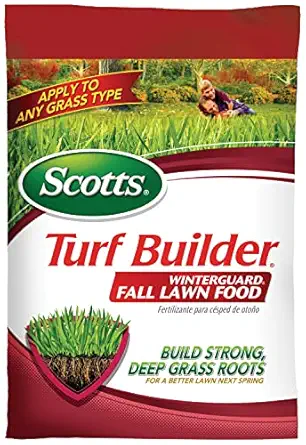Maintaining a lush and healthy Bermuda grass lawn requires a strategic approach throughout the year. This seasonal planner outlines all the essential tasks to keep your lawn in peak condition.
Spring (March – May)
Soil Testing:
- Test soil pH and nutrient levels to determine if amendments are needed (ideal pH: 6.0-7.0).
Fertilization:
- Apply a nitrogen-rich fertilizer once the grass begins to green up and soil temperatures reach 65°F.

Scotts Turf Builder Weed & Feed, Weed Killer Plus Lawn Fertilizer, Controls Dandelion and Clover
Weed Control:
- Use a pre-emergent herbicide to prevent summer weeds.
- Spot-treat existing weeds with a post-emergent herbicide.
Aeration (Optional):
- Aerate the lawn if the soil is compacted to improve root growth and nutrient absorption.
Mowing:
- Begin mowing as soon as the grass grows above 2 inches. Set the mower height to 1-2 inches.
Watering:
- Water deeply but infrequently, ensuring 1-1.5 inches of water per week.
Summer (June – August)
Fertilization:
- Apply a balanced fertilizer every 6-8 weeks to support vigorous growth.

Scotts Turf Builder Southern Lawn Fertilizer for Southern Grass
Mowing:
- Mow frequently to maintain a height of 1-2 inches. Avoid cutting more than 1/3 of the blade length at a time.
Watering:
- Increase watering frequency during hot, dry periods to prevent drought stress.
- Aim for 1-1.5 inches of water weekly, applied early in the morning.
Pest Management:
- Monitor for pests like armyworms and grubs. Treat infestations promptly with appropriate insecticides.
Disease Management:
- Watch for diseases and fungus that may infect the lawn and treat it with herbicide.
Weed Control:
- Spot-treat weeds as needed to prevent competition with Bermuda grass with weed control.
Fall (September – November)
Gradual Mowing Adjustment:
- Gradually lower mowing height to 1-1.5 inches in preparation for dormancy.
Fertilization:
- Apply a potassium-rich fall fertilizer 4-6 weeks before the first frost to strengthen roots for winter.

Scotts Turf Builder WinterGuard Fall Lawn Fertilizer for All Grass Types
Weed Control:
- Apply a pre-emergent herbicide to prevent winter weeds like poa annua.
Overseeding (Optional):
- Overseed with ryegrass for a green lawn during winter if desired.
Aeration (Optional):
- Aerate the lawn if it wasn’t done in spring.
Watering:
- Reduce watering frequency as temperatures cool but keep soil slightly moist.
Winter (December – February)
Weed Control:
- Spot-treat any visible winter weeds.
Mowing:
- Cease mowing once the grass is fully dormant.
Watering:
- Water sparingly, only during extended dry periods to prevent root dehydration.
Lawn Clean-Up:
- Remove leaves, debris, and excess thatch to reduce the risk of fungal diseases.
Monitor for Pests:
- Check for signs of pests that may affect dormant grass, such as grubs.